7.疾病负担研究的组织实施-周麦耕
死因监测工作计划(周脉耕)

中国疾控中心慢病中心监测组
报告内容
中国死因监测工作开展现状 2005年死因监测工作计划
中国死因监测工作开展现状
死亡资料报告系统(途径) 死因监测工作规范 死因报告质量
死亡资料报告系统
全国疾病监测点系统(DSP) 居民病伤死亡报告系统 医院死亡网络直报
各系统间的主要区别
覆盖地区 数据接收单位 软件 数据收集形式
影响死亡资料报告质量的因素
数据收集形式 城乡差异 殡葬习惯 户口管理 死因诊断和推断水平等
有待做的几件事
整合多个死亡资料报告系统 统一报告程序,出台死因监测工作规范 统一软件和数据接受单位,加强培训
2005年年初对2004年的死亡数据进行分析、 年度报告撰写,并做好信息备份、公布与反馈工作。 预计2005年8月底完成2004年死亡年报的撰写。
谢谢大家!
以下为附加内容
让更多的农民成为新型职业农民
中央农业广播电视学校 刘天金 2013˙05˙07 陕西
农业部部长韩长赋: 这是一项基础性工程、创新性工作,
——聚焦“谁来种地”“地如何种”
(二)紧迫课题 一、为什么要大力培育新型职业农民
◆“谁来种地”“地如何种”是一个问题的 两个方面
——农村劳动力结构性不足:“不是 没人种地,而是这地由什么人来种”
——创新农业生产经营方式:“不是 种不过来,而是怎么种得更好”
(三)历史使命 一、为什么要大力培育新型职业农民
◎中央经济工作会议、中央农村工作会议:要稳定完善强农 惠农富农政策,充分保护和调动农民生产经营积极性, 使务农种粮有效益、不吃亏、得实惠。
◎2013年中央一号文件:农村劳动力大量流动,农户兼业化、 村庄空心化、人口老龄化趋势明显,农民利益诉求多元, 加强和创新农村社会管理势在必行。
《疾病负担研究》课件

传染病仍不可忽视
03
尽管传染病发病率有所下降,但仍对全球健康构成威胁,特别
是在低收入国家。
主要疾病负担的地区分布
1 2
亚洲地区疾病负担最重
由于人口众多和医疗资源有限,亚洲地区面临最 大的疾病负担。
非洲地区传染病负担较重
非洲地区由于卫生条件差和医疗资源匮乏,传染 病发病率和死亡率较高。
3
北美洲和欧洲慢性病负担增加
关注弱势群体和欠发达地 区
针对弱势群体和欠发达地区, 制定针对性的疾病防控措施, 降低这些地区的疾病负担。
未来研究方向与展望
深入研究特定疾 病的负担
针对特定疾病,如癌症、心 血管疾病等,深入研究其负 担情况,为制定针对性的防 控措施提供依据。
探索新的数据来 源和评估方法
随着科技的发展,新的数据 来源和评估方法将不断涌现 ,为疾病负担研究提供更多 可能性。
疾病负担研究对于制 定公共卫生政策、预 防和控制疾病具有重 要意义
研究目的与意义
研究目的
通过对疾病负担的全面研究,了解各种疾病的发病率、死亡率、伤残率等指标 ,评估不同疾病的危害程度,为制定科学合理的公共卫生政策提供依据。
研究意义
有助于提高公众对疾病负担的认识,促进健康意识的提升;有助于优化医疗资 源配置,提高疾病防治效果;有助于推动公共卫生领域的研究和发展,为全球 健康事业做出贡献。
04
YLD是指因疾病导致的失能所损失的生命年,用于衡量失能对健康的 影响。
疾病负担的影响因素
遗传因素是指个体的基因组成对 疾病发生的影响。
环境因素包括自然环境和社会环 境,如空气质量、水污染、社会 经济状况等对疾病发生的影响。
行为因素包括饮食习惯、运动量 、吸烟、饮酒等对疾病发生的影 响。
《护理研究》考查课试题和答案——中国医科大学

《护理研究》考查课试题和答案——中国医科大学中国医科大学2013年7月考试《护理研究》考查课试题一、单选题(共20 道试题,共20 分。
)1. 下列四种类型效度中最能反映研究工具质量好坏的是DA. 表面效度B. 内容效度C. 效标关联效度D. 结构效度满分:1 分2. 下列有关选题注意事项的描述不正确的是BA. 选题范围要宽广B. 选择熟悉的领域进行研究C. 避免完全重复他人工作D. 注意研究问题的可行性满分:1 分3. 下列不属于结构式访谈通常适用的情况是CA. 研究者已拥有大量系统性的相关文献B. 研究者对访谈内容之外的其他内容或资料不感兴趣C. 访谈需要在研究者严格控制下进行等D. 对于未知的或新领域的探索性研究满分:1 分4. 生物医学研究中首先应该考虑的一项重要伦理原则是DA. 有益的原则B. 知情同意原则C. 公正的原则D. 尊重人尊严的原则满分:1 分5. 在“体重与血压的关系的研究”中,自变量是AA. 体重B. 血压C. 研究对象的年龄D. 测量血压的时间满分:1 分6. 对于呈正态分布的计量资料来说,用于描述其集中趋势的统计学指标是DA. 均数B. 中位数C. 构成比D. 标准差满分:1 分7. 某研究者采用工作倦怠量表,测评护士的工作倦怠,欲分析年龄与工作倦怠总分的相关性,应选择的统计学分析方法是DA. 两独立样本t检验B. 方差分析C. 秩和检验D. 相关分析满分:1 分8. 选择研究的病例时选用的标准不统一引起的偏倚为BA. 入院率偏倚B. 诊断性偏倚C. 诊断怀疑性偏倚D. 衡量性偏倚满分:1 分9. 下列不属于观察法的缺点是AA. 伦理问题B. 结果偏差C. 耗费资金D. 主观性满分:1 分10. 选择研究对象主要服从于AA. 研究目的B. 随机原则C. 规定的样本数D. 选题背景资料满分:1 分11. 下列资料的收集可以采用观察法的是DA. 疼痛B. 头晕C. 睡**型态D. 认知改变满分:1 分12. 关于设对照组的描述不正确的说法是AA. 所有的研究都应该设对照组B. 设对照组可达到排除外变量的影响C. 设实验组和对照组可使两组的干****素尽量保持一致D. 设对照组可突出试验**素的影响满分:1 分13. 护理人员在申请课题时,应首先仔细查阅下列哪项内容BA. 基金申请通知B. 申请注意事项C. 项目指南D. 课题经费管理办法满分:1 分14. 下列哪一种效度可以反映研究工具与其他测量标准之间的关系DA. 表面效度B. 内容效度C. 结构效度D. 效标关联效度满分:1 分15. 下列哪种情况的文献不能引用BA. 近期3-5年的文献B. 未发表的学术研究C. 研究生论文库D. 网络参考文献满分:1 分16. 在“同伴教育对糖尿病患者足部护理相关知识的影响”这一研究课题中,自变量是CA. 同伴教育这种健康教育方式B. 患者患有糖尿病的时间C. 患者有关足部护理的相关知识水平D. 患者的足部状况评定满分:1 分17. 四种抽样方法按抽样误差由小至大排列的正确顺序是CA. 整群抽样<分层抽样<系统抽样<单纯随机抽样B. 分层抽样<整群抽样<单纯随机抽样<系统抽样C. 分层抽样<系统抽样<单纯随机抽样<整群抽样D. 单纯随机抽样<系统抽样<分层抽样<整群抽样满分:1 分18. 论文的前言部分一般不包括下列哪些内容AA. 研究的背景和理由B. 既往的研究成果,存在的问题C. 研究的目的D. 研究的主要内容满分:1 分19. 在研究中设对照组的主要目的是DA. 确定研究对象B. 确定研究方法C. 增加研究可信度D. 排除干****素的影响满分:1 分20. 哪种方法要花费较多时间和精力设计研究工具,并做出精确的统计分析,但不足之处是资料不够深入。
中国慢病分析(下)国内外慢病管理现状及MTM模式

中国慢病行业分析(下)——国内外慢病管理现状及MTM模式探索近年来,慢性非传染性疾病(慢病)的爆发式增长,导致管理和治疗患有多种慢病的患者面临挑战。
这篇文章的目的是本文通过了解中美慢性疾病的现状与管理方式,探讨MTM服务在国内应用的可行性。
一,MTM服务模式90年代美国兴起的一种由专业药剂师提供的药物治疗管理服务,即药物治疗管理MTM (Medication Therapy Management,MTM)。
MTM管理旨在帮助患者更好的了解他们的身体状况和用药情况,从而提高他们的生活质量的服务。
服务内容包括提高患者对自身疾病的认知,普及用药规则,保证用药正确性,减少药物浪费,全面认知不良反应以及不良反应的应对方案等内容。
另外从药物治疗审阅、个人用药记录、药物相关干预计划、治疗记录、治疗跟进和五个步骤保证MTM的全面性。
二,国内外患病慢病现状分析根据世界卫生组织(WTO)数据显示,每年慢性疾病会夺去约3800万人的生命。
根据世界经济论坛(WEF)推测,在未来10年内,全球慢性疾病将带来47万亿的经济冲击。
(一)美国慢病患病现状及管理模式1. 慢性疾病患病现状在美国,每十个成年人中有六位患有慢性疾病。
慢性疾病如心脏病、癌症和糖尿病等是美国死亡和致残的主要原因。
他们每年推动美国3.3万亿美元医疗保健消费。
根据美国控制疾病中心(CDC)的调查数据表明,每年造成大约170万美国人死于慢性病。
事实上,现今四分之一的美国成年人患有两种或以上的慢性病,超过一半的老年人患有≥3种慢性病。
随着年龄增长,这些类型的共病发生率可能也会大大提高,据美国目前人口统计,从现在起到2029年,每天约有1万美国人步入65岁老年人大关。
因此合并症患者的总数只会有增无减。
据悉,慢性病就占医疗总支出的75%左右;在公众保险方面,慢性疾病的医疗费用占比超90%,医疗补助占比超80%。
因此,管理和预防慢性疾病是美国社会的一个重要目标。
《临床流行病学》慕课学堂云试题集及答案
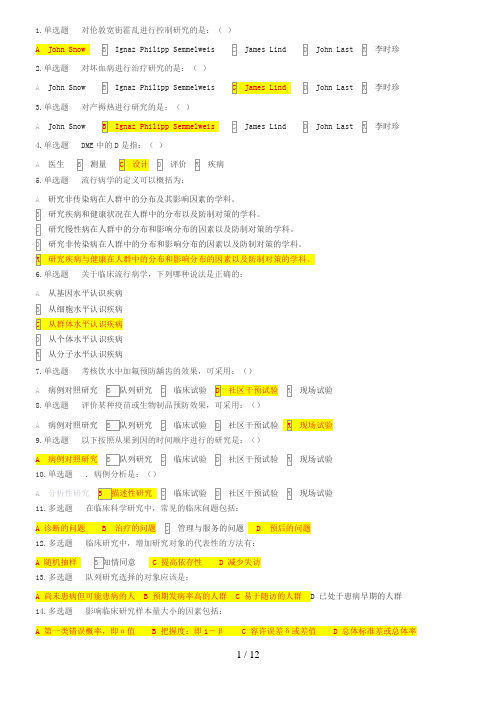
1.单选题对伦敦宽街霍乱进行控制研究的是:()2.单选题对坏血病进行治疗研究的是:()3.单选题对产褥热进行研究的是:()4.单选题DME中的D是指:()5.单选题流行病学的定义可以概括为:A 研究非传染病在人群中的分布及其影响因素的学科。
6.单选题关于临床流行病学,下列哪种说法是正确的:A 从基因水平认识疾病7.单选题考核饮水中加氟预防龋齿的效果,可采用:()8.单选题评价某种疫苗或生物制品预防效果,可采用:()9.单选题以下按照从果到因的时间顺序进行的研究是:()10.单选题. 病例分析是:()11.多选题在临床科学研究中,常见的临床问题包括:12.多选题临床研究中,增加研究对象的代表性的方法有:13.多选题队列研究选择的对象应该是:A 尚未患病但可能患病的人B 预期发病率高的人群C 易于随访的人群D 已处于患病早期的人群14.多选题影响临床研究样本量大小的因素包括:A 第一类错误概率,即α值B 把握度:即1-βC 容许误差δ或差值D 总体标准差或总体率15.判断题Kappa指数和符合率都是用来判断可靠性的指标。
正确16.判断题临床实验中最好的对照方式是历史对照。
错误17.单选题在临床研究中,有关“纳入标准”和“排除标准”的阐述,哪条是不对的?A“纳入标准”即在符合诊断标准的条件下,规定选择对象的范围B 不符合纳入标准即为“排除标准”C 在对象选择中,必须有明确的“纳入标准”和“排除标准”D“排除标准”是指在研究对象符合“纳入标准”的条件下,再规定一些不适合作为研究对象的条件18.单选题诊断试验研究中的对照组应该是:19.单选题临床试验的研究因素是:A 药物、手术及其他治疗措施B 病人、医师、护士C 转归、费用、满意度D 药物、疗效、病人20.单选题下列哪条不是确定临床研究观察指标的基本原则21.单选题临床实验中,保证组间均衡的最好办法是:22.单选题关于临床实验中的盲法,下列哪条是对的?A 盲法包括单盲和双盲两种B单盲是指医生不知道谁是实验组C单盲是指病人不知道谁是实验组D单盲是指资料分析者不知道谁是实验组23.单选题流行病学对“暴露”的最确切描述是:A 是指研究对象接触某种物质B 具备某种特征C 处于某种状态D 具有研究者所要研究的某个“因”24.单选题利用现成记录进行研究的优点不包括:A 研究费用相对较低B 研究所需时间较少C 资料比较全面D 记录的准确性高于个别访谈获得的资料25.单选题目前疾病负担的主要测量指标包括:A 发病率、潜在减寿年数(PYLL)和伤残调整寿命年(DALY)B 死亡率、潜在减寿年数(PYLL)和感染率C 死亡率、病死率和伤残调整寿命年(DALY)D 死亡率、潜在减寿年数(PYLL)和伤残调整寿命年(DALY)26.单选题流行病学中绝对效应的测量指标包括A 病因率差、病因危险度差、病因平均无病时间差B OR、病因危险度差、病因平均无病时间差C 病因率差、RR、病因平均无病时间差D 病因率差、病因危险度差、发病时间27.多选题暴露测量的内容包括28.多选题日记法的主要优点包括29.多选题在流行病学中,“续发率”可用于:A 比较传染病传染力的强弱B 评估疾病的流行水平C 分析不同条件对传染病传播的影响D 评价卫生防疫措施效果30.多选题常用的描述临床结局的指标有31.判断题增加样本可减少随机误差,但不能减少系统误差正确32.判断题感染率的意义与发病率相似错误33.单选题为提高诊断的灵敏度,对几个独立试验可()34.单选题若某项诊断指标高滴度与疾病发生有关系,则将诊断标准降低一个稀释度很可能会导致:()A灵敏度和特异度均增加B特异度减小而灵敏度增加E灵敏度增加,特异度则根据周围情况增加或减小35.单选题特异度是指:()A实际有病按照诊断标准判为无病的百分比B实际有病按照诊断标准判为有病的百分比C实际无病按照诊断标准判被正确判为无病的百分比D实际无病按照诊断标准判为有病的百分比E阳性结果中真正无病的人所占百分比36.单选题灵敏度是指:()A实际有病按照诊断标准判为无病的百分比B实际无病按照诊断标准判为有病的百分比C实际无病按照诊断标准判被正确判为无病的百分比D实际有病按照诊断标准判被正确判为有病的百分比E阳性结果中真正无病的人所占百分比37.单选题某医生用尿糖和血糖试验来联合诊断糖尿病,他决定只要一个试验结果为阳性,就诊断为糖尿病,这种联合试验的方式是:()38.单选题为了提高诊断结果的阳性预测值,最有效办法是()。
开展肿瘤疾病负担研究,推动肿瘤防治科学决策要点

[11]王宝华,王宁,冯雅靖,等.1990年与2013年中国人群胃癌疾病 负担分析[J]中华流行病学杂志,2016,37(6):763—767.D0l:
10.3760/cma.i issn.0254—64502016.06.004. Wang BH,W觚g N,Feng YJ,et a1.Disease burden Of stomach cancer in the Chinese population,in 1990 and 2013 J J.Cbin J
随着我国社会经济的快速发展,城市化、工业化
35.8%,死亡占全球的37.6%;肝癌新发病例占全球
进程的加・陕和人口的老龄化,肿瘤已成为影响居民 健康最重要的公共卫生问题之一。据2015年中国 居民营养与慢性病状况报告揭示…,中国居民癌症 年发病率为235.0/10万(每年新发病例约309万),死
亡率为144.3/10万(每年死亡人数约200万),其中 男性多于女性,农村人群多于城市人群;从癌谱来
YLL、YLD和DALY等指标。为了便于不同地区、不
期“肿瘤疾病负担”栏目中的7篇论著阳删采用全球 疾病负担(GBD)的研究方法,综合分析人群流行病 学调查、疾病监测、生命登记、人口普查等多源数据, 对全国及各省自1990年以来主要癌症的发病、死亡 和寿命损失加以阐述,并对影响肿瘤疾病负担的危 险因素和防治策略进行深入分析,希望能为广大癌
2.开展伤残权重调查,准确估登记报告信息系统、全国肿瘤登记数据、 澳门地区和香港地区死因数据;发病数据来源于全 国肿瘤登记数据以及文献回顾。为保证数据质量, 对死亡和发病数据均进行了质量评估和处理。其
中,对死亡数报告较少的监测点未纳入分析,对发病 数据中某年某一登记点肿瘤死亡占总死亡数比例过 高(>80%)者也未纳入分析。由于同一时期内,某
社会医学模拟考试题(附答案)
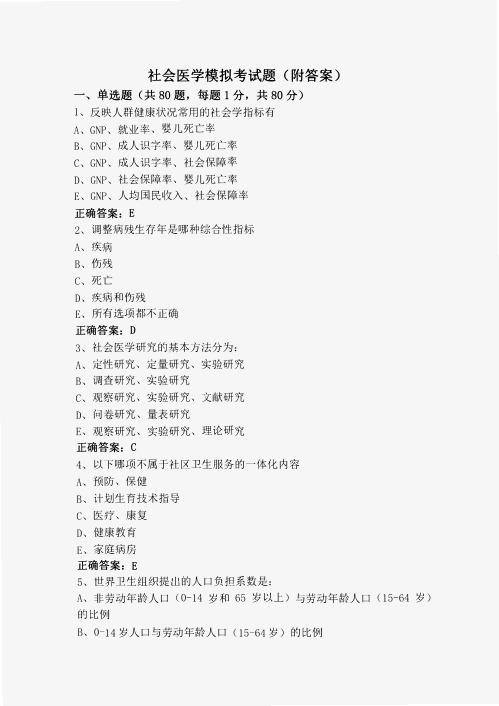
社会医学模拟考试题(附答案)一、单选题(共80题,每题1分,共80分)l、反映人群健康状况常用的社会学指标有A、GNP、就业率、婴儿死亡率B、GNP、成人识字率、婴儿死亡率C、GNP、成人识字率、社会保障率D、GNP、社会保障率、婴儿死亡率E、GNP、人均国民收入、社会保障率正确答案: E2、调整病残生存年是哪种综合性指标A、疾病B、伤残C、死亡D、疾病和伤残E、所有选项都不正确正确答案: D3、社会医学研究的基本方法分为:A、定性研究、定量研究、实验研究B、调查研究、实验研究C、观察研究、实验研究、文献研究D、问卷研究、量表研究E、观察研究、实验研究、理论研究正确答案: C4、以下哪项不属于社区卫生服务的一体化内容A、预防、保健B、计划生育技术指导C、医疗、康复D、健康教育E、家庭病房正确答案: E5、世界卫生组织提出的人口负担系数是:A、非劳动年龄人口(0-14岁和65岁以上)与劳动年龄人口(15-64岁)的比例B、O—14岁人口与劳动年龄人口(15—64岁)的比例C、65岁以上人口与劳动年龄人口(15—64岁)的比例D、非劳动年龄人口(0-14岁和65岁以上)与劳动年龄人口(15-60岁)的比例E、O—14岁人口与劳动年龄人口(15—60岁)的比例正确答案:A6、慢性非传染性疾病死亡概率的数学单位是A、十万分比B、百分比C、千分比D、万分比E、百万分比正确答案: A7、下列哪项不是健康危险因素的特点A、潜伏期长人B、联合作用明显C、特异性强D、广泛存在E、以上均包括正确答案: C8、新中国成立初期制定了卫生工作的四大方针,把卫生工作的重点转向广大人民结果到改革开放初的30年间,我国人均寿命增长34岁,是许多发达国家不可想象和比拟的。
这反映的健康影响因素是A、文化影响B、社会制度C、经济发展D、社会人口E、卫生事业发展正确答案: B9、绘制人口金字塔需要A、各年龄组的总人口数B、各年龄组的男性和女性人口数C、各年龄组的男性人口数D、各年龄组的女性人口数E、全人口数正确答案: B10、健康相关生命质量的研究对象包括A、患者B、健康者C、流行病学家D、患者和健康者E、所有选项都不正确正确答案: D11、健康相关生命质量的研究对象包括A、健康者B、医护人员C、患者D、患者、健康者和医护人员E、患者和健康者正确答案: E12、在健康危险因素个体评价中,“健康型”的人:A、评价年龄大于实际年龄B、评价年龄大于增长年龄C、评价年龄小千实际年龄D、评价年龄小千增长年龄E、以上答案都不对正确答案: C13、以下哪项不是社区卫生服务的内容A、行为干预B、社区服务C、开展危险因素调查和干预D、社区监测E、卫生宣传正确答案: B14、目前谈到的医学模式转变是指A、神灵主义的医学模式向社会医学模式的转变B、生物医学模式向生物、心理、社会医学模式的转变C、自然哲学的医学模式向生物、心理、社会医学模式的转变D、生物医学模式向社会医学模式的转变E、机械论的医学模式向新医学模式的转变正确答案: B15、第一次卫生革命的对象是A、急、慢性传染病和寄生虫病B、慢性传染病C、寄生虫病D、社会病E、非传染性疾病正确答案: A16、计算生命质量指数需要的三个指标是A、出生率、死亡率、期望寿命B、出生率、婴儿死亡率、15岁以上人口识字率C、就业率、孕产妇死亡率、国民生产总值D、婴儿死亡率、1岁平均期望寿命、15岁以上人口识字率E、婴儿死亡率、孕产妇死亡率、人均国民生产总值增长率正确答案: D17、健康相关生命质量不考察哪项A、一般性的总体感觉B、临床诊断和实验室检查结果C、社会适应能力D、心理能力E、身体功能正确答案: B18、在健康危险因素个体评价中,“健康型”的人A、评价年龄大千实际年龄B、评价年龄大于增长年龄C、评价年龄小于实际年龄D、评价年龄小于增长年龄E、以上答案都不对正确答案: C19、生命质量测量中最为敏感的内容是A、角色功能B、活动受限C、认知功能D、一般性感觉E、情绪反应正确答案: E20、测量人群对某事物的主观态度,宜采用哪种研究方法:A、文献研究B、实验研究C、定量调查D、案例研究E、定性调查正确答案: C21、有关医学模式,以下错误的是A、医学模式是在不同历史阶段和医学科学水平下,观察与处理医学问题的思想与方法B、是对健康与疾病总体的特点和本质的概括C、医学模式是永恒不灭的D、其核心是医学观E、它研究医学的属性、职能和发展规律正确答案: C22、信度是指A、测量工具的稳定性和可靠性B、测量工具的有效性C、测量工具的准则D、与研究目的的吻合度E、所有选项都正确正确答案: A23、健康相关生命质量评价内容不包括哪项A、心理状态B、身体状态C、一般性感觉D、社会功能状态E、临床检查的验证正确答案: E24、社区卫生服务指的是A、治疗常见病和多发病B、治疗小伤小病C、负责特殊人群的基本医疗服务D、环境卫生E、所有选项都不正确正确答案: E25、进行个体健康危险因素评价时,某个体的实际年龄为44岁,评价年龄为47.5岁,增长年龄为39岁,则该个体的评价结果属于A、健康型B、自创性危险因素型C、难以改变的危险因素型D、少量危险因素型E、个体危险因素低于平均水原的平型正确答案: B26、现代医学的主要目的:A、救死扶伤和治病救人B、预防疾病和延长寿命C、减轻痛苦和挽救生命D、预防疾病以上全包括和损伤,促进和维护健康;解除由病灾引起的疼痛和疾苦;照料和治愈有病的人,照料些不能治愈的人;避免早死,追求安详死亡E、尊重人的选择和尊严的原则正确答案: D27、首次提出生物-心理-社会医学模式的科学家是A、笛卡尔B、希波克拉底C、恩格尔D、魏尔啸E、培根正确答案: C28、创造性是科研工作者选题时应遵循的基本原则之一,其含义包括A、先进性B、新颖性C、独创性D、突破性E、所有选项都包括正确答案: E29、以下哪项不属千初级卫生保健的八项要素A、增进必要的营养,充足的安全饮用水B、妇幼保健和计划生育C、健康教育D、基本药物供应E、慢性病的防治正确答案: E30、应用健康危险因素评价方法对某位45岁男性进行个体定型分析,发现其评价年龄为47岁、增长年龄(或可达到年龄)为41岁。
第十一章疾病经济负担分析
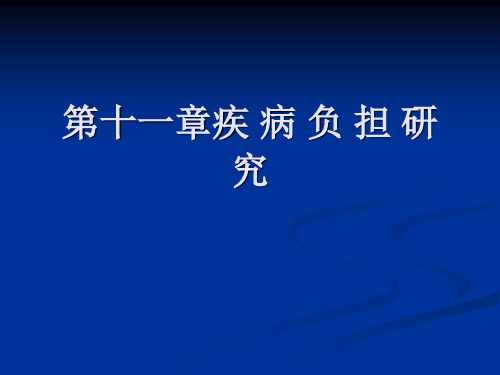
5.伤残调整寿命年(Disability- adjusted life year,DALY):指从 发病到死亡所损失的全部健康年,包 括因早死所致的寿命损失和疾病所致 伤残引起的健康寿命损失年两部分。
第二节 疾病负担研究的发展过程
一、疾病负担研究的发展
(一)第一阶段:1982年以前 ,疾病负担主要由死 亡率来衡量,认为疾病造成的死亡越多,疾病负担就 越大。此阶段应用的研究指标主要是死亡率或死因 位次、发病率等传统指标。这类指标的优势在于数 据资料相对易于掌握,计算简便,结果直观。然而, 单从死亡的角度来看,伤害导致病人在30岁死亡与 肺癌造成病人在60岁死亡并无差别。可见,死亡率 并不能反映疾病对人的社会价值即社会生产造成的 影响。发病率可以从频数上反映疾病危害的大小, 但是却难以反映疾病所造成的伤残程度和持续时间。
作为目前最具有代表性的疾病负担评价 和测量方法,DALY虽然比以往指标更全
面反映了疾病对人群造成的负担,但对 其有效性和实用性还是存在一些争议。
二、常用疾病负担的评价指标
(一) 死亡指标 测定疾病负担的死亡指标有: 粗死亡率(Crude Death Rate, CDR) 疾病死亡专率 死亡比(Proportional Mortality Ratio,PMR) 减寿年数(PYLL)。
三、健康寿命年损失的计算方法
一种疾病造成健康寿命年的损失一般包括5个方面的内容:
1、 死亡造成的减寿年数 2、 死亡前由于伴有残疾失能者造成的减寿年数 3、 死亡前因残疾造成的减寿年数 4、 永久性残疾造成的减寿年数 5、 急性发病时造成的减寿年数
1、 死亡造成的减寿年数 每千人口因某病死亡造成的健康寿命年损失(A)
六、疾病负担的计算
(一) 疾病负担主要是计算疾病所形成的直接费用和 间接费用
流行病学_厦门大学中国大学mooc课后章节答案期末考试题库2023年

流行病学_厦门大学中国大学mooc课后章节答案期末考试题库2023年1.属于选择偏倚的是:答案:入院率偏倚_奈曼偏倚_检出症候偏倚_领先时间偏倚2.常用的流行病学病因及不良反应的研究方法有:答案:描述性研究_病例对照研究_队列研究_实验流行病学研究3.横断面研究与生态学研究的根本区别在于:答案:研究单位是否为群体4.实验流行病学研究中,控制信息偏倚力度最大的试验设计是答案:三盲试验5.实验流行病学研究中,实验组与对照组人群的最大不同是答案:干预措施不同6.临床试验中,对照组使用安慰剂的目的是答案:提高对照组的依存性7.拟对最新研制出的一种预防某种传染性疾病的疫苗预防效果进行评价,应选择的研究人群是答案:发病率高的人群8.甲乙两地未标化前肺癌的粗死亡率相等,但甲地人口构成中老年男性人口居多,则甲乙两地死亡率的实际情况是:答案:乙地肺癌的死亡率要高于甲地9.一项调查发现,A病的患病率高于B病,但两种疾病的发病率和季节波动是相同的,可能的原因是:答案:B病患者比A病恢复得快10.评价试验可靠性的常用指标有答案:变异系数_Kappa 值_符合率11.选项中的指标都可用来评价筛检试验方法可靠性的是答案:相关系数、变异系数和Kappa值12.流行病学研究方法的核心是:答案:对比分析13.肝癌是我国排名前五的恶性肿瘤之一,且各期的治疗效果一般都较差,患者I年生存率仅为32.03%,HBV病毒感染是肝癌的主要病因,我国约10%的成年人有HBV感染。
有人建议在 HBV人群中开展肝癌筛查(甲胎蛋白检测或超声诊断),你是否赞同,主要理由是答案:不赞同,筛查岀来的病例后续无有效的治疗方案14.用生存时间评价筛查效果时,最可能会产生的偏倚是答案:领先时间偏倚15.若甲、乙两人群某病患病率分别为10% 和20%,某项筛检试验分别应用于甲、乙群体,则下述正确的是答案:试验阴性者中假阴性所占比例,甲人群低于乙人群16.影响筛检试验阳性预测值的是答案:患病率17.流行病学的病因定义为:答案:使疾病发生概率升高的因素18.在300名病例与300名对照的1:1匹配的病例对照研究中,有200名病例与50名对照具有暴露史,据此资料,计算OR值为:答案:无法计算19.筛检试验A的灵敏度为80%,筛检试验B的灵敏度为90%,若将A、B试验并联,则灵敏度最有可能为:答案:0.9920.为提高筛检试验的灵敏度,可釆用答案:并联试验21.某诊断试验指标的截断值确定后,该试验结果的阳性预测值取决于答案:患病率22.假定某病的患病率为10‰,用某项灵敏度为80%的筛检试验检查1000人的人群,则漏诊人数为答案:223.某筛检试验的灵敏度为80%,特异度为80%,请问该筛检试验的阳性似然比和阴性似然比分别为答案:4和0.2524.某筛检试验检测病例组得出某一结果的概率与对照组得出同一结果的概率的比值为答案:似然比25.以下不是经接触传播所致传染病的流行特征的选项是答案:有明显的季节性和地区性特点26.阴性预测值的定义是答案:试验阴性者中真正为非患者的概率27.普査中对400例有乳腺癌的妇女和400名正常妇女进行X线检查,结果在前者中100 例阳性,后者50例阳性。
中风和缺血性心脏病成我国主要疾病负担
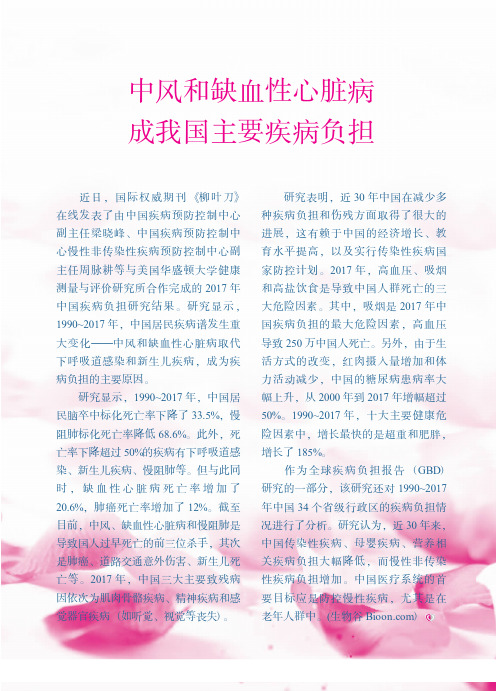
近日,国际权威期刊《柳叶刀》在线发表了由中国疾病预防控制中心副主任梁晓峰、中国疾病预防控制中心慢性非传染性疾病预防控制中心副主任周脉耕等与美国华盛顿大学健康测量与评价研究所合作完成的2017年中国疾病负担研究结果。
研究显示,1990~2017年,中国居民疾病谱发生重大变化———中风和缺血性心脏病取代下呼吸道感染和新生儿疾病,成为疾病负担的主要原因。
研究显示,1990~2017年,中国居民脑卒中标化死亡率下降了33.5%,慢阻肺标化死亡率降低68.6%。
此外,死亡率下降超过50%的疾病有下呼吸道感染、新生儿疾病、慢阻肺等。
但与此同时,缺血性心脏病死亡率增加了20.6%,肺癌死亡率增加了12%。
截至目前,中风、缺血性心脏病和慢阻肺是导致国人过早死亡的前三位杀手,其次是肺癌、道路交通意外伤害、新生儿死亡等。
2017年,中国三大主要致残病因依次为肌肉骨骼疾病、精神疾病和感觉器官疾病(如听觉、视觉等丧失)。
研究表明,近30年中国在减少多种疾病负担和伤残方面取得了很大的进展,这有赖于中国的经济增长、教育水平提高,以及实行传染性疾病国家防控计划。
2017年,高血压、吸烟和高盐饮食是导致中国人群死亡的三大危险因素。
其中,吸烟是2017年中国疾病负担的最大危险因素,高血压导致250万中国人死亡。
另外,由于生活方式的改变,红肉摄入量增加和体力活动减少,中国的糖尿病患病率大幅上升,从2000年到2017年增幅超过50%。
1990~2017年,十大主要健康危险因素中,增长最快的是超重和肥胖,增长了185%。
作为全球疾病负担报告(GBD)研究的一部分,该研究还对1990~2017年中国34个省级行政区的疾病负担情况进行了分析。
研究认为,近30年来,中国传染性疾病、母婴疾病、营养相关疾病负担大幅降低,而慢性非传染性疾病负担增加。
中国医疗系统的首要目标应是防控慢性疾病,尤其是在老年人群中。
(生物谷)中风和缺血性心脏病成我国主要疾病负担。
防慢性病得下猛药
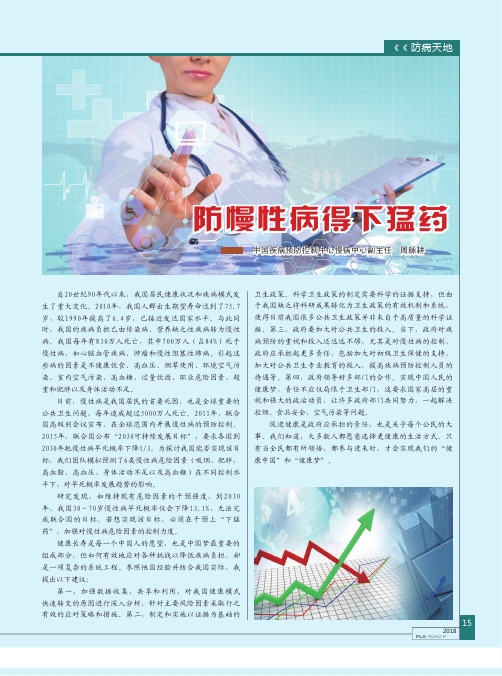
《《 防病天地PLA HEALTH201815自20世纪90年代以来,我国居民健康状况和疾病模式发生了重大变化。
2010年,我国人群出生期望寿命达到了75.7岁,较1990年提高了6.4岁,已接近发达国家水平。
与此同时,我国的疾病负担已由传染病、营养缺乏性疾病转为慢性病。
我国每年有830万人死亡,其中700万人(占84%)死于慢性病,如心脑血管疾病、肿瘤和慢性阻塞性肺病。
引起这些病的因素是不健康饮食、高血压、烟草使用、环境空气污染、室内空气污染、高血糖、过量饮酒、职业危险因素、超重和肥胖以及身体活动不足。
目前,慢性病是我国居民的首要死因,也是全球重要的公共卫生问题,每年造成超过5000万人死亡。
2011年,联合国高级别会议宣布,在全球范围内开展慢性病的预防控制。
2015年,联合国公布“2030可持续发展目标”,要求各国到2030年把慢性病早死概率下降1/3。
为探讨我国能否实现该目标,我们团队模拟预测了6类慢性病危险因素(吸烟、肥胖、高血脂、高血压、身体活动不足以及高血糖)在不同控制水平下,对早死概率发展趋势的影响。
研究发现,如维持现有危险因素的干预强度,到2030年,我国30~70岁慢性病早死概率仅会下降13.1%,无法完成联合国的目标。
若想实现该目标,必须在干预上“下猛药”,加强对慢性病危险因素的控制力度。
健康长寿是每一个中国人的愿望,也是中国梦最重要的组成部分,但如何有效地应对各种挑战以降低疾病负担,却是一项复杂的系统工程。
参照他国经验并结合我国实际,我提出以下建议:第一,加强数据收集、共享和利用,对我国健康模式快速转变的原因进行深入分析,针对主要风险因素采取行之有效的应对策略和措施。
第二,制定和实施以证据为基础的卫生政策。
科学卫生政策的制定需要科学的证据支持,但由于我国缺乏将科研成果转化为卫生政策的有效机制和系统,使得目前我国很多公共卫生政策并非来自于高质量的科学证据。
第三,政府要加大对公共卫生的投入。
降低疾病负担,促进全民健康

降低疾病负担,促进全民健康周脉耕;梁晓峰【期刊名称】《中国循环杂志》【年(卷),期】2018(033)012【总页数】2页(P1145-1146)【作者】周脉耕;梁晓峰【作者单位】100037 北京市,中国疾病预防控制中心慢性非传染性疾病预防控制中心;100037 北京市,中国疾病预防控制中心慢性非传染性疾病预防控制中心【正文语种】中文【中图分类】R541中国高速发展的经济推动了工农业现代化、城市化的繁荣发展,也推动了城乡居民生活水平、饮食营养、生活方式等发生根本性改变。
随之而来,居民对健康的追求也更为突出和迫切,人民健康已经提升到了国家战略高度。
通过对人群疾病负担进行测量,可反映人群疾病、伤残以及危险因素的分布和水平,是评价健康状况、制定干预措施和配置卫生资源的重要依据。
作为拥有近14亿人口的最大发展中国家,中国的疾病负担对全球疾病负担结果具有重要影响。
2011年,中国疾病预防控制中心(CDC),与美国华盛顿大学健康测量与评价中心(IHME)建立合作关系,并签署合作备忘录,参与全球疾病负担2010(GBD2010)研究,同时Yang等[1]在《柳叶刀》发表了1990~2010年中国人群的健康模式和疾病负担。
2015年中国CDC与IHME正式成立“中国疾病负担研究合作中心(CBDSCC)”,致力于长期开展中国疾病负担的科研、技术推广和政策转化工作。
同年,Zhou等[2]在《柳叶刀》发表了1990~2013年中国各省疾病负担结果,首次公布了省际间死亡和期望寿命及其变化存在较大差异性,该结果对于确定各省的循证决策优先领域至关重要,得到社会的高度关注。
CBDSCC联合IHME定期、及时、系统地分析梳理中国历年健康相关数据,定期更新估计中国及各省人群的期望寿命和健康期望寿命、死因模式、伤残寿命损失、危险因素暴露与归因负担等疾病负担指标,为卫生政策制定和资源分配提供数据支持。
经过广大卫生工作者与社会各界数十年的共同努力,我国居民健康水平得到逐步提高,传染病与母婴疾病死亡率大幅下降,期望寿命显著增长。
2022助理健康管理师《理论知识》过关练习试卷 含答案

2022助理健康管理师《理论知识》过关练习试卷含答案考试须知:1、考试时间:120分钟,本卷满分为100分。
2、请首先按要求在试卷的指定位置填写您的姓名、准考证号等信息。
3、请仔细阅读各种题目的回答要求,在密封线内答题,否则不予评分。
姓名:______考号:______一、单选题(本题共70小题,每题1分,共70分)1、以下哪项是衡量人群中疾病负担的指标()A、生存率B、感染率C、死亡率D、发病率E、患病率2、下列关于流行病学的说法错误的是﹙﹚A、流行病学已深入临床医学的研究中B、流行病学是从群体角度研究疾病与健康C、流行病学研究的病种仅限于传染病D、流行病学从疾病分布入手探讨疾病的流行因素E、流行病学属于预防医学的范畴3、近年来,随着经济的发展可能带来的健康问题有()A、慢性非传染性疾病、心理紧张、环境污染B、环境污染、婴儿死亡率增高、人口寿命降低C、营养不良、心理障碍、精神分裂症D、传染病、车祸、心理紧张4、对一位已婚肥胖男性实施饮食干预,最好的支持性环境是()A、家庭B、学校C、单位D、社会E、社区5、健康风险评估个人反馈报告不包括()A、全国疾病患者病例B、健康教育手册C、健康信息清单D、疾病危险性评价E、现患疾病及家族史6、一个好的计划的具体目标必须包括()A、可测量的B、可完成的C、可信的D、有时间性的E、以上都是7、有学者通过调查肺癌病人和非肺癌的人过去的吸烟情况,来研究吸烟和肺癌的关系。
这种方法称为:()A、现况调查B、描述性研究C、筛检试验D、病例对照研究E、队列研究8、我国黄建始教授研究组()年通过文献查阅和专家咨询查找和确认了目前有科学证据支持的()个健康危险因素。
A、2006、10B、2007、11C、2008、12D、2009、139、健康相关行为是指()A、与疾病相关的行为B、与健康和疾病有关的行为C、与健康有关的行为D、促进健康的行为10、()、适当的健康检查以及慢性病风险评估共同构成健康评估的三个主要部分。
降压、降脂,防国人心血管病意义最大!周脉耕、胡国清等预测研究

降压、降脂,防国人心血管病意义最大!周脉耕、胡国清等预测研究近日,2021年《中国心血管健康与疾病报告》正式发布。
报告指出,中国每5例死亡中就有2例死于心血管病。
中国疾控中心周脉耕、中南大学湘雅公共卫生学院胡国清等预测,根据危险因素在1990~2015年的自然变化趋势,2030年我国心脑血管疾病的死亡例数(612万例)和死亡率(428/10万)较2015年将分别增长59.92% 和 52.87%。
但研究显示,如果到2030 年危险因素全部达标,可预防229万例心脑血管病死亡。
在单个危险因素控制达标的情况下,血压、总胆固醇和细颗粒物暴露是对心脑血管疾病死亡数影响最大的3个因素,可分别减少死亡133、61和 31万例。
其中,血压控制对缺血性心脏病和出血性脑卒中死亡的贡献最大,分别可减少67.73和39.11万例的死亡。
研究者指出,我国是心血管病的高发地区,其中约67%的心血管死亡与行为方式、代谢和环境因素的暴露相关。
2030 年我国男性和女性心脑血管疾病的过早死亡概率均呈持续下降的趋势,相较于2015年,男性由11.43% 降至11.28%,女性由5.79% 降至4.43%。
这项研究通过应用2015年全球疾病负担估算的中国数据进行了预测研究,其中纳入分析的危险因素包括吸烟、身体活动不足、体重指数高、总胆固醇升高、血压升高、空腹血糖升高、高盐饮食和PM2.5。
我国的“健康中国2030”规划纲要提出以心脑血管疾病为代表的慢性病防控目标,明确指出2030年重大慢性病的早死概率应比2015年降低30%。
来源:[1]中国心血管健康与疾病报告编写组.中国心血管健康与疾病报告2021概要.中国循环杂志, 2022, 36: 553-578. DOI:10.3969/j.issn.1000-3614.2022.06.001.【。
1990~2016年中国及省级行政区疾病负担报告
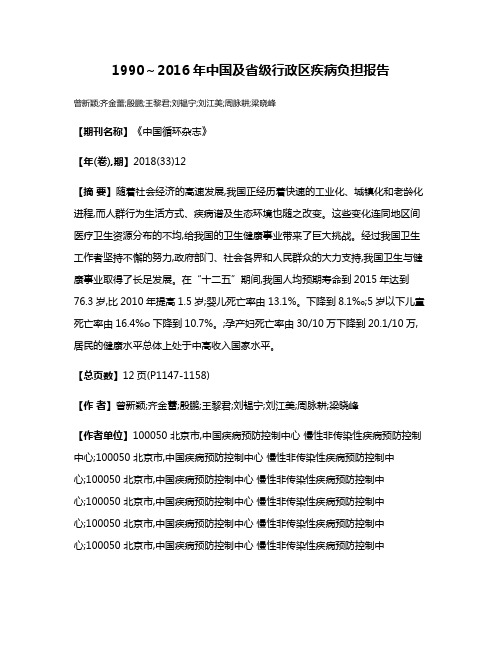
1990~2016年中国及省级行政区疾病负担报告曾新颖;齐金蕾;殷鹏;王黎君;刘韫宁;刘江美;周脉耕;梁晓峰【期刊名称】《中国循环杂志》【年(卷),期】2018(33)12【摘要】随着社会经济的高速发展,我国正经历着快速的工业化、城镇化和老龄化进程,而人群行为生活方式、疾病谱及生态环境也随之改变。
这些变化连同地区间医疗卫生资源分布的不均,给我国的卫生健康事业带来了巨大挑战。
经过我国卫生工作者坚持不懈的努力,政府部门、社会各界和人民群众的大力支持,我国卫生与健康事业取得了长足发展。
在“十二五”期间,我国人均预期寿命到2015年达到76.3岁,比2010年提高1.5岁;婴儿死亡率由13.1%。
下降到8.1‰;5岁以下儿童死亡率由16.4%o下降到10.7%。
;孕产妇死亡率由30/10万下降到20.1/10万,居民的健康水平总体上处于中高收入国家水平。
【总页数】12页(P1147-1158)【作者】曾新颖;齐金蕾;殷鹏;王黎君;刘韫宁;刘江美;周脉耕;梁晓峰【作者单位】100050 北京市,中国疾病预防控制中心慢性非传染性疾病预防控制中心;100050 北京市,中国疾病预防控制中心慢性非传染性疾病预防控制中心;100050 北京市,中国疾病预防控制中心慢性非传染性疾病预防控制中心;100050 北京市,中国疾病预防控制中心慢性非传染性疾病预防控制中心;100050 北京市,中国疾病预防控制中心慢性非传染性疾病预防控制中心;100050 北京市,中国疾病预防控制中心慢性非传染性疾病预防控制中心;100050 北京市,中国疾病预防控制中心慢性非传染性疾病预防控制中心;100050 北京市,中国疾病预防控制中心慢性非传染性疾病预防控制中心【正文语种】中文【中图分类】R541【相关文献】1.1990~2016年中国及省级行政区心血管病疾病负担报告 [J], 李镒冲;刘世炜;曾新颖;周脉耕2.1990年至2017年口腔癌的全球和区域负担:疾病全球负担研究报告 [J], 任振虎;胡传宇;贺海蓉;李媛洁;吕军3.1990—2017年中国伤害负担:2017年全球疾病负担研究结果(摘译) [J], 林泽婷;吕来文;黄晓晴4.1990年与2019年中国归因于室外PM2.5暴露的心血管疾病负担分析 [J], 何敏;齐金蕾;殷鹏;王黎君;周脉耕5.1990年与2017年中国8种消化道疾病的疾病负担分析 [J], 李路遥;郑忠立;甘信利;郭幸沛;訾豪;菅志远;任学群;曾宪涛因版权原因,仅展示原文概要,查看原文内容请购买。
2017公共卫生专硕考研真题汇总之名词解释
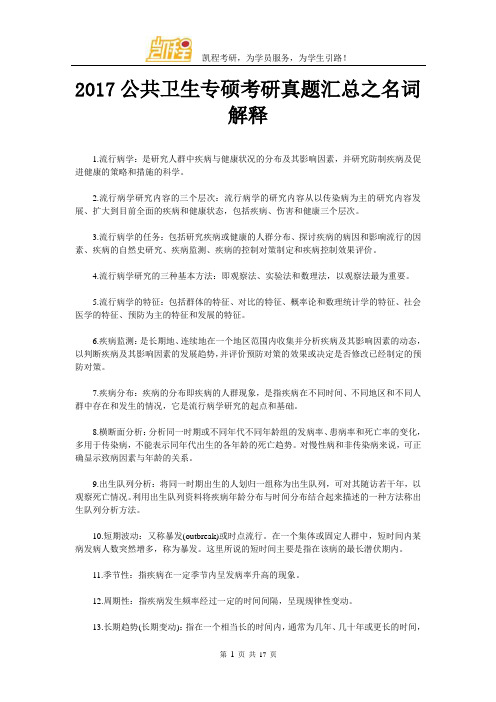
2017公共卫生专硕考研真题汇总之名词解释1.流行病学:是研究人群中疾病与健康状况的分布及其影响因素,并研究防制疾病及促进健康的策略和措施的科学。
2.流行病学研究内容的三个层次:流行病学的研究内容从以传染病为主的研究内容发展、扩大到目前全面的疾病和健康状态,包括疾病、伤害和健康三个层次。
3.流行病学的任务:包括研究疾病或健康的人群分布、探讨疾病的病因和影响流行的因素、疾病的自然史研究、疾病监测、疾病的控制对策制定和疾病控制效果评价。
4.流行病学研究的三种基本方法:即观察法、实验法和数理法,以观察法最为重要。
5.流行病学的特征:包括群体的特征、对比的特征、概率论和数理统计学的特征、社会医学的特征、预防为主的特征和发展的特征。
6.疾病监测:是长期地、连续地在一个地区范围内收集并分析疾病及其影响因素的动态,以判断疾病及其影响因素的发展趋势,并评价预防对策的效果或决定是否修改已经制定的预防对策。
7.疾病分布:疾病的分布即疾病的人群现象,是指疾病在不同时间、不同地区和不同人群中存在和发生的情况,它是流行病学研究的起点和基础。
8.横断面分析:分析同一时期或不同年代不同年龄组的发病率、患病率和死亡率的变化,多用于传染病,不能表示同年代出生的各年龄的死亡趋势。
对慢性病和非传染病来说,可正确显示致病因素与年龄的关系。
9.出生队列分析:将同一时期出生的人划归一组称为出生队列,可对其随访若干年,以观察死亡情况。
利用出生队列资料将疾病年龄分布与时间分布结合起来描述的一种方法称出生队列分析方法。
10.短期波动:又称暴发(outbreak)或时点流行。
在一个集体或固定人群中,短时间内某病发病人数突然增多,称为暴发。
这里所说的短时间主要是指在该病的最长潜伏期内。
11.季节性:指疾病在一定季节内呈发病率升高的现象。
12.周期性:指疾病发生频率经过一定的时间间隔,呈现规律性变动。
13.长期趋势(长期变动):指在一个相当长的时间内,通常为几年、几十年或更长的时间,疾病的致病因素、临床表现、发病率、死亡率、预后等疾病特点发生显著变化。
中国各省寿命均有提高 健康不平等现象仍存在
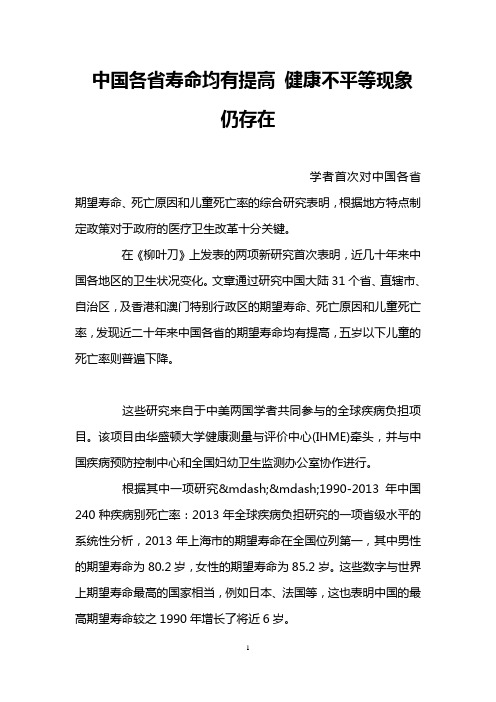
中国各省寿命均有提高健康不平等现象仍存在学者首次对中国各省期望寿命、死亡原因和儿童死亡率的综合研究表明,根据地方特点制定政策对于政府的医疗卫生改革十分关键。
在《柳叶刀》上发表的两项新研究首次表明,近几十年来中国各地区的卫生状况变化。
文章通过研究中国大陆31个省、直辖市、自治区,及香港和澳门特别行政区的期望寿命、死亡原因和儿童死亡率,发现近二十年来中国各省的期望寿命均有提高,五岁以下儿童的死亡率则普遍下降。
这些研究来自于中美两国学者共同参与的全球疾病负担项目。
该项目由华盛顿大学健康测量与评价中心(IHME)牵头,并与中国疾病预防控制中心和全国妇幼卫生监测办公室协作进行。
根据其中一项研究——1990-2013年中国240种疾病别死亡率:2013年全球疾病负担研究的一项省级水平的系统性分析,2013年上海市的期望寿命在全国位列第一,其中男性的期望寿命为80.2岁,女性的期望寿命为85.2岁。
这些数字与世界上期望寿命最高的国家相当,例如日本、法国等,这也表明中国的最高期望寿命较之1990年增长了将近6岁。
尽管全国的期望寿命都所有增长,且普遍认为这与日益增长的GDP以及更加完善的孕产妇教育有着紧密的联系,但各省之间仍然存在着巨大的差距。
例如,一些西部地区的男女期望寿命较之全国最高水平低了大约10岁,与孟加拉国等南亚不发达国家的期望寿命相仿。
此外,研究还显示了各省之间主要死亡原因存在的很大差异。
在全国范围,脑血管疾病(导致中风的主要原因)是男性和女性死亡的首要原因,也是欠发达省份的主要死因。
但在一些省份,尤其是中国南部边境的云南省,由脑血管疾病导致的死亡率则非常低。
在云南,由吸烟及空气污染导致的慢性阻塞性肺疾病是首要死亡原因,这与其他很多南部和西部省份(包括重庆、四川、甘肃、青海和贵州)的首要死亡原因一致;而北部省份的主要死亡原因则是心脏病,其中心脏病死亡率在最高省份与最低省份之间相差3倍。
- 1、下载文档前请自行甄别文档内容的完整性,平台不提供额外的编辑、内容补充、找答案等附加服务。
- 2、"仅部分预览"的文档,不可在线预览部分如存在完整性等问题,可反馈申请退款(可完整预览的文档不适用该条件!)。
- 3、如文档侵犯您的权益,请联系客服反馈,我们会尽快为您处理(人工客服工作时间:9:00-18:30)。
中国疾病预防控制中心
全球健康危险因素——主要危险因素归因死亡和疾病负担
1、危险因素简介 1.1 Purpose of this report.......................................................................................... 1 1.2 Understanding the nature of health risks.......................................................... .. 1 1.3 The risk transition................................................................................................ 2 1.4 Measuring impact of risk........................................................................... .......... 4 1.5 Risk factors in the update for 2004...................................................................... 5 1.6 Regional estimates for 2004................................................................................. 7 2、主要危险因素的归因死亡和疾病负担 2.1 Global patterns of health risk................................................................................ 9 2.2 Childhood and maternal undernutrition.................................................... ........ 13 2.3 Other diet-related risk factors and physical inactivity......................................... 16 2.4 Sexual and reproductive health.......................................................................... 19 2.5 Addictive substances.......................................................................................... 21 2.6 Environmental risks........................................................................................... 23 2.7 Occupational and other risks.............................................................................. 25 3、危险因素的联合效应 3.1 Joint contribution of risk factors to specific diseases........................................... 28 3.2 Potential health gains from reducing multiple risk factors............ ...................... 29 3.3 Conclusions............................... .................... .............. ........... ... ...... .......... 31 Annex A: Data and methods References
2004年全球疾病负担报告内容简介
第一部分:前言 Overview of the Global Burden of Disease Study.............................................................. 2 What is new in this update for 2004?................................................................................. 3 Regional estimates for 2004.............................................................................................. 5 第二部分:死亡原因 1. Deaths in 2004: who and where?.................................................................................. 8 2. Deaths by broad cause groups...................................................................................... 8 3. Leading causes of death.............................................................................................. 11 4. Cancer mortality........................................................................................................... 12 5. Causes of death among children aged under five years................. ................... ......... 14 6. Causes of death among adults aged 15–59 years.................................. .................... 17 7. Years of life lost: taking age at death into account........................ ................ .............. 21 8. Projected trends in global mortality: 2004–2030....................... .......................... ........ 22 第三部分:发病、患病和伤残 9. How many people become sick each year?.......................... ............... ..................... .28 10. Cancer incidence by site and region............................................ ............................. 29 11. How many people are sick at any given time?.......................... .................. ...... ....... 31 12. Prevalence of moderate and severe disability................................. ......... ................ 31 13. Leading causes of years lost due to disability in 2004......... ................ ........ ............ 36 第四部分:疾病负担 14. Broad cause composition.............................................................. ........................... 40 15. The age distribution of burden of disease............................... ................................. 42 16. Leading causes of burden of disease........................... ..................... ....................... 42 17. The disease and injury burden for women................................................... ............. 46 18. The growing burden of noncommunicable disease....................... .......... ................ .47 19. The unequal burden of injury................................................... ................. ............... .48 20. Projected burden of disease in 2030............................ ........ .................................... 49
